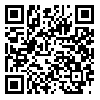BibTeX | RIS | EndNote | Medlars | ProCite | Reference Manager | RefWorks
Send citation to:
URL: http://ijn.iums.ac.ir/article-1-2194-en.html
2- PhD candidate in Medical Education, Department of Medical Education, Isfahan University of Medical Sciences, Isfahan, Iran.
3- Master of Health Services Management, Health Services Management Research Center, Institute for Futures Studies in Health, Kerman University of Medical Sciences, Kerman, Iran.
4- Professor of Epidemiology, Research Center for Modeling in Health, Institute for Futures Studies in Health, Kerman University of Medical Sciences, Kerman, Iran.
5- Bachelor of Health Services Management, Shafa Clinical Research Committee, Kerman University of Medical Sciences, Kerman, Iran (Corresponding author). Tel: +983431217315 Email: mmaskari142@yahoo.com
Abstract
Background & aims: Nursing students gain personal, professional and clinical skills from their clinical teachers in clinical settings. It should be noted that any deficiencies in clinical education decreases the efficiency and performance of graduating students. Thus, the role of clinical teachers and their quality of teaching are pivotal in clinical education. The purpose of this study was to determine the perspective of nursing students about the characteristics of an effective clinical teacher.
Material & Methods: This was a descriptive cross-sectional study during the first and second academic year of 2013. Based on convenience sampling 115 nursing students who were on their clinical wards in affiliated hospitals of Kerman University of Medical Sciences, Iran entered the study. A valid and reliable questionnaire, its face and content validity were approved by obtaining the opinions of medical education and nursing experts, was used to gather data. The questionnaire contained pre-specified items in 2 sections relating to demographic characteristics of respondents and characteristics of an efficient clinical teacher. All tests were conducted with SPSS version 16. For data analysis, descriptive tests (mean and standard deviation) and analytical test (cluster analysis) were conducted.
Results: The highest mean scores for characteristics of an efficient clinical teacher were given to features as appropriate appearance (8.88) respectful to colleagues (8.42), respectful to patients (8.40), respectful to students (8.34), being good tempered (8.27), and professionalism (8.26). Totally, 2 broad characteristics were identified. Based on cluster analysis these characteristics can be classified into personal traits and clinical teaching skills.
Conclusion: Personal traits and clinical teaching skills play a pivotal role in educating nursing students. Consequently, paying attention to these characteristics in clinical settings can enhance students' performance and improve the higher education system.
Received: 2015/05/9 | Accepted: 2015/08/8 | Published: 2015/08/8
| Rights and permissions | |
 |
This work is licensed under a Creative Commons Attribution-NonCommercial 4.0 International License. |





